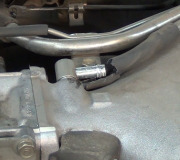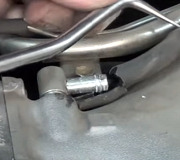Here's a few things to consider. First of all, when you disconnected the battery, the Engine Computer lost its memory. It has to relearn "minimum throttle" before it will know when to be in control of idle speed. Until then it may be hard to start unless you hold the accelerator pedal down 1/4", it won't give you the nice idle flare-up to 1500 rpm at start-up, and it will tend to stall at stop signs. To meet the conditions for the relearn to take place, drive at highway speed with the engine warmed up, then coast for at least seven seconds without touching the pedals.
Next, when you have an idle speed that's too high, you need a scanner to see why that is occurring. The Engine Computer will set the automatic idle speed motor to one of 256 positions as necessary to keep the idle speed as desired. The scanner will display "AIS Steps" For a properly running engine you'll find it at around step 32 in neutral. If idle speed is too high and it's near step 0, the computer is trying to lower the idle speed without success. Typically that's due to a vacuum leak. If the steps are unusually high, like step 50, that would be in response to a misfiring cylinder, but when the actual idle speed is too high too, the computer is raising the speed in response to something, and that is typically because of a low temperature sensor reading or it is anticipating a load on the engine like running the air conditioning compressor. The compressor runs in cold weather in the defrost mode too, so if the AC is disabled or non-functioning, you will still get a change in idle speed when you turn on the defroster.
You may want to have the alternator professionally load-tested for maximum output current and "ripple" voltage. Your maximum current should be around 75 amps, as I recall. If the most you can get is around 25 amps, exactly one third of its rating, it has a defective diode inside. That means you're losing one of the three output phases. During the missing phase, output voltage will drop a lot and that will confuse the Engine Computer. It will also interfere with sensor readings. That can have an affect on the MAP sensor, and wrong readings from it, by as little as.05 volts, will have a big affect on fuel metering. The alternator has to be tested on the engine. Too many people take them off and haul them to an auto parts store for testing. Those testers aren't strong enough to run an alternator under maximum load for a few seconds. That takes five to eight horsepower. Test benches have up to one horsepower motors. All they'll tell you is if you have SOME output. You need to know how much output.
On a related note, the alternator is mounted on rubber bushings. To complete the circuit for the output current to flow, there is a ground cable or a braided ground strap bolted to it and to the engine block. Check that cable to see if it is corroded. If just a few strands are all that's left, you won't get full output current through it. The clue there is when running the engine with many loads on, like head lights heater fan, and rear window defogger, you will measure a voltage between the alternator housing and the engine block or battery negative post. That voltage should be 0.0 volts. To find one or two tenths of a volt is normal but it shouldn't be much higher than that.
Temperature sensors have an extremely low failure rate because there's just one component in them. Almost all failures, except on Fords, are due to corroded connector terminals, a break in a wire, or it was unplugged while the ignition switch was turned on. Corroded terminals have to get bad enough before a code will set. Until then the added resistance of that corrosion will raise the voltage the computer sees, and higher voltage translates into lower temperature. If the computer thinks it's 20 degrees colder than it really is, it is going to add too much fuel to the calculation. Liquid gas does not burn. It just goes out the tail pipe, wasted. Gasoline has to be a vapor to burn and turning into a vapor is harder in colder temperatures. Years ago we accounted for that by adding a choke. That dumped way too much fuel into the engine in hopes a high enough percentage would vaporize to burn and make sufficient power. That isn't such a big problem when using fuel injection, but throttle body injection systems run at a pretty low pressure and atomizing the fuel isn't very efficient. We still need to add fuel, and the throttle body temperature sensor, intake air temperature, (IAT) sensor, or battery temperature sensor are the ones that tell the computer how much to add.
Regardless if there's a code or not, you need a scanner to see what temperature the computer thinks the incoming air is. That value will stay fairly constant once the engine is running, and the coolant temperature reading must be the same before the engine is started. That one, of course, will go up as the engine warms up, but the two sensor readings must be the same at start-up of a cold engine.
Sunday, January 5th, 2014 AT 1:40 PM


